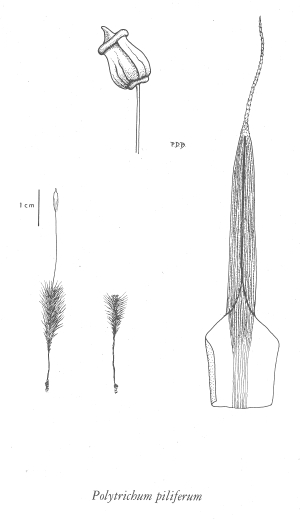Polytrichum piliferum Hedw.
awned haircap moss (polytrichum moss)
Polytrichaceae
Species Account Author: Wilf Schofield
Extracted from Some Common Mosses of BC
Introduction to the Bryophytes of BC
awned haircap moss (polytrichum moss)
Polytrichaceae
Species Account Author: Wilf Schofield
Extracted from Some Common Mosses of BC
Introduction to the Bryophytes of BC
Species Information
Species description:
Species name referring to the white hair points of the leaves.
Comments:
P. piliferum is extremely tolerant of long periods of dryness and, in the dry condition, of extremely high temperatures in its open sunny habitat. It, like P. juniperinum, is a reliable indicator of nutrient poor soil.
Distinguishing characteristics:
The very long, white hair point and incurved blade of the leaf over the lamellae, mark this species of sterile habitats.
Habit:
Plants usually bluish-green, forming relatively short turfs 10-20 mm tall with wine-reddish stems; sometimes the whole plant, except the long, white hair points of the leaves, tinged with red.
Similar Species:
P. piliferum resembles P. juniperium in many respects. In P. piliferum, the white hair points are usually much longer (about 1/8 the length of the leaf) and taper abruptly from the body of the leaf; those of P. juniperinum are red, usually less than 1/8 of the leaf length and taper gradually from the body of the leaf. P. strictum is a miniature version of P. juniperinum, differing from it in its abundant felting of rhizoids along much of the stem length, its leaves that are generally half the size of those of P. juniperinum and in its usually boggy habitat.
Illustration

If more than one illustration is available for a species (e.g., separate illustrations were provided for two subspecies) then links to the separate images will be provided below. Note that individual subspecies or varietal illustrations are not always available.
Illustration Source: Some Common Mosses of BC
Habitat and Range
Habitat
Shallow soil over outcrops, open sandy soil of banks and disturbed areas from sea level to alpine elevations. Range
World DistributionCosmopolitan, more frequent in temperate and frigid climates.